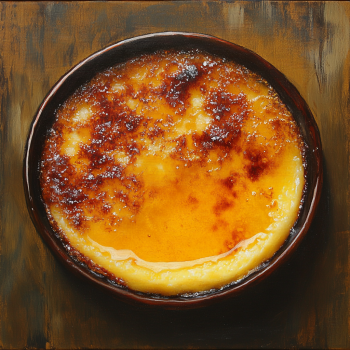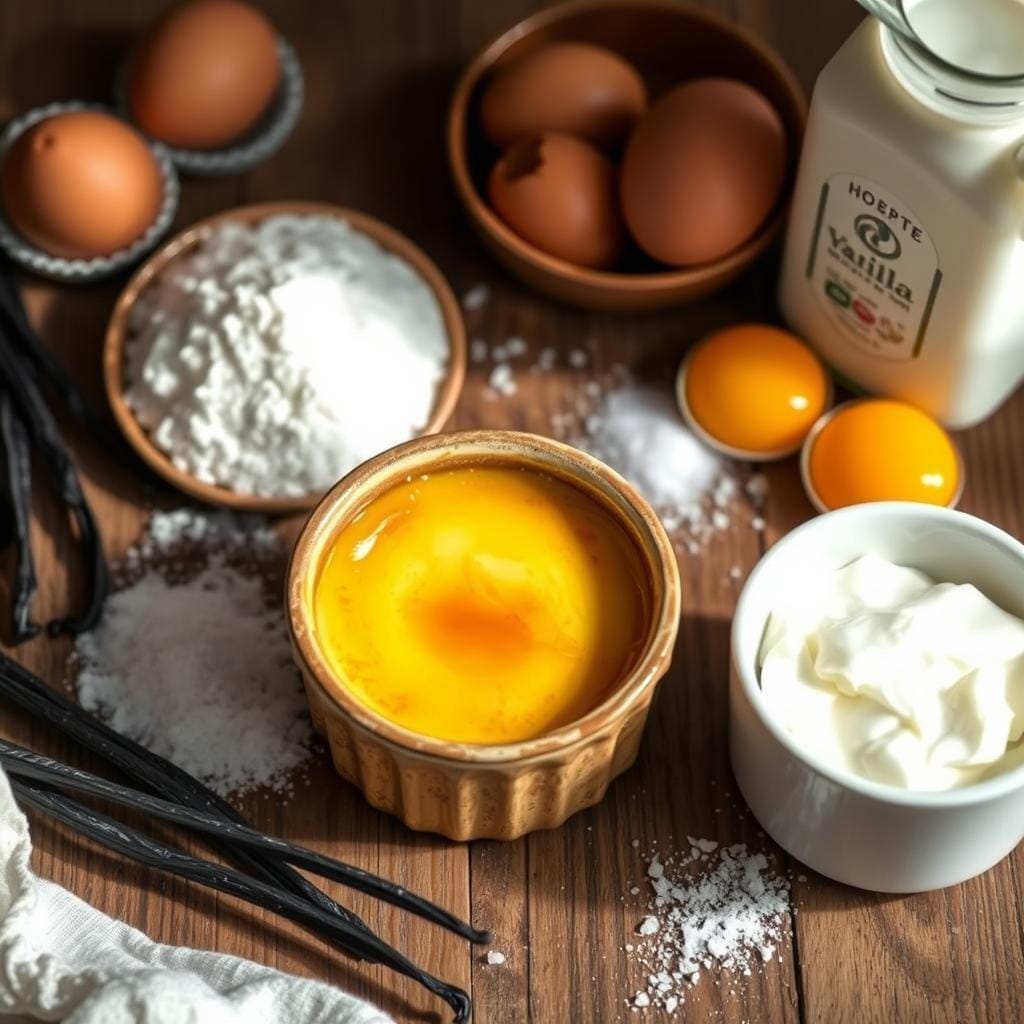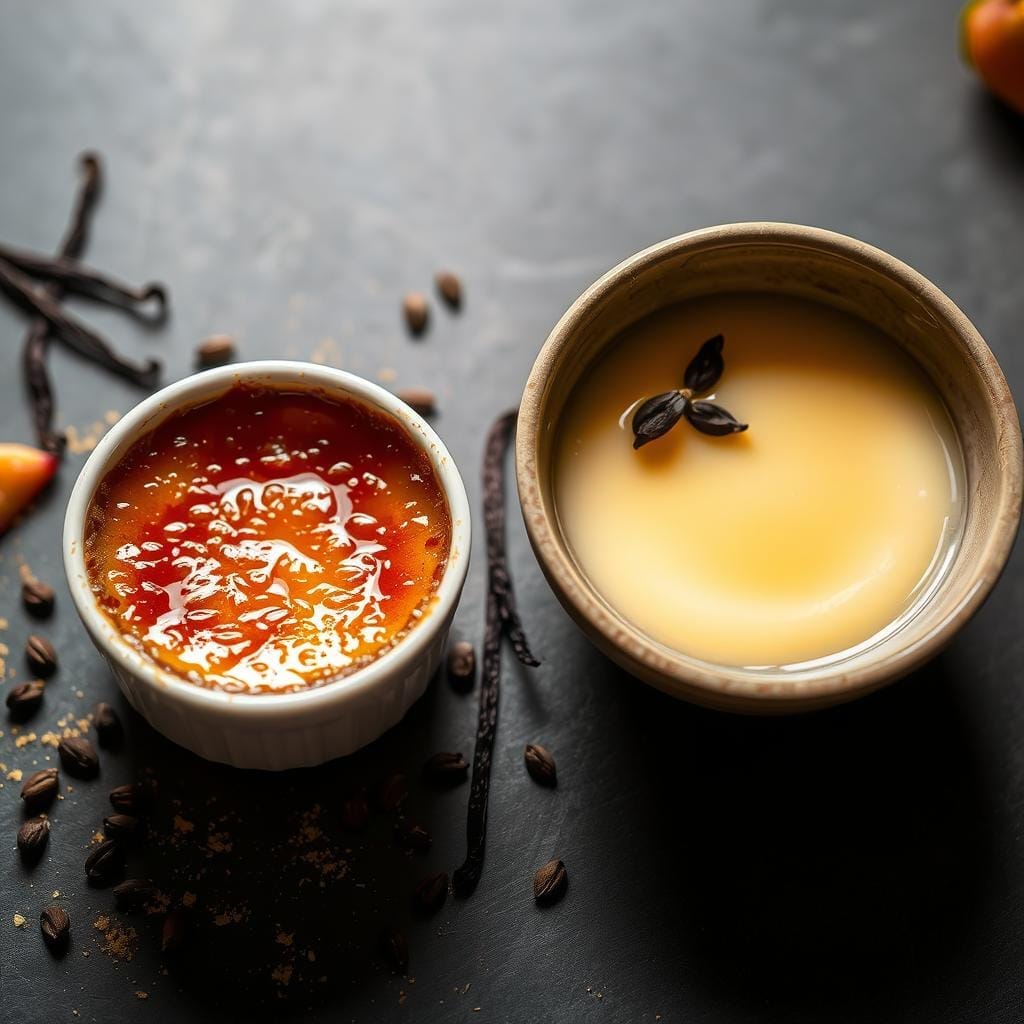Imagine sitting in a cozy café, the air filled with the scent of vanilla and the gentle clink of dessert spoons. Crème brûlée arrives at your table—its delicate sugar crust crackling under your spoon to reveal rich, creamy custard beneath. This elegant dessert isn’t just a feast for the senses—it’s a simple but luxurious treat made from just a few ingredients.

In this complete guide, we’ll answer a common question: what is crème brûlée made of? We’ll explore its traditional ingredients, how it’s made, the science behind its creamy texture and glassy topping, and even how it compares to custard. Whether you’re a dessert lover or a home baker, this article will give you everything you need to appreciate and perfect this classic treat.
Key Takeaways
- Crème brûlée is made with heavy cream, egg yolks, sugar, and vanilla.
- A crisp caramelized sugar topping is created just before serving.
- The custard is typically baked in ramekins using a water bath.
- The dessert’s texture depends on fat content and cooking technique.
What Is Crème Brûlée Made Of?
Crème brûlée is made of a silky custard base topped with a layer of caramelized sugar. The core ingredients include:

- Heavy Cream: Provides richness and a velvety mouthfeel.
- Egg Yolks: Essential for thickening and structure.
- Granulated Sugar: Used in both the custard and the topping.
- Vanilla: Adds aromatic flavor—typically in extract or bean form.
Some recipes may include salt for balance or espresso/chocolate for variation.
When combined, these ingredients create a delicate, custard-like dessert that’s creamy underneath and crisp on top.
Crème Brûlée vs Custard: What’s the Real Difference?
At first glance, crème brûlée is a custard—but not all custards are crème brûlée.

| Feature | Crème Brûlée | Regular Custard |
|---|---|---|
| Topping | Caramelized sugar crust | Typically none or soft toppings |
| Flavor Base | Always includes vanilla | May vary: vanilla, chocolate, etc |
| Cooking Method | Baked in water bath, then torched | Baked or cooked on stovetop |
| Texture | Rich and creamy | Varies by recipe |
Crème brûlée is also more indulgent due to its high-fat content and the signature contrast of textures.
The Custard Base: Cream, Milk & Egg Yolks
Heavy Cream vs Milk
Heavy cream (36%+ fat) is the gold standard for a rich custard. Some recipes blend in whole milk for a lighter texture.
| Dairy Type | Fat Content | Result in Custard |
| Heavy Cream | 36%+ | Thick, rich, and creamy |
| Half & Half | 10–18% | Balanced but still creamy |
| Whole Milk | ~3.25% | Lighter texture |
Why Egg Yolks Matter
Egg yolks provide emulsification and a smooth, luxurious consistency. Too few yolks? The custard won’t set properly. Too many? It may become dense.
A standard recipe uses 4–6 yolks per 2 cups of cream.
Sweetness & Caramelization
The magic of crème brûlée lies in its perfect balance of creamy sweetness and a crisp, caramelized sugar shell. In this section, we’ll explore how different sugars influence flavor and texture — and reveal the techniques behind achieving that iconic golden crust that cracks with every spoonful.
Granulated Sugar in Custard
White sugar blends easily and adds sweetness without overpowering flavor. It caramelizes evenly under a torch or broiler.
Using Brown Sugar or Turbinado
For deeper flavor, some chefs sprinkle turbinado or brown sugar on top. These sugars create a more complex, molasses-like finish.
How to Make the Perfect Brûlée Topping
Caramelization Methods
- Blowtorch: The most controlled and effective option.
- Broiler: Works in a pinch but may unevenly melt sugar.
- Stovetop Caramel: A pour-over option, though less common.
Pro Tip: Only caramelize right before serving to keep the sugar crisp.
Tools You’ll Need
- Whisk and mixing bowls
- Ramekins (4–6 oz size)
- Fine mesh strainer
- Kitchen torch or broiler
Baking Technique: Water Bath for Silky Custard
The secret to crème brûlée’s velvety texture? A gentle bake in a water bath.
- Preheat oven to 325°F (163°C).
- Place filled ramekins in a baking dish.
- Add hot water halfway up the sides.
- Bake for 30–35 minutes until custard is set but slightly jiggly.
What to Serve with Crème Brûlée
Want to take your dessert to the next level? Try pairing crème brûlée with:
- Fresh berries (raspberries, blueberries)
- Espresso or coffee
- Biscotti or shortbread
- A glass of dessert wine like Sauternes
The goal: balance the richness with acidity or texture.
The Sweet Finish
Crème brûlée is a timeless dessert that delivers a perfect blend of rich custard and crispy sugar. Made with simple ingredients—heavy cream, egg yolks, sugar, and vanilla—this dessert rewards careful technique and attention to detail.
Whether you’re trying it for the first time or refining your recipe, understanding the ingredients and methods will help you create an unforgettable dessert experience.
Craving a bold, savory twist? Try our Crab Brûlée Recipe—a show-stopping appetizer that takes crème brûlée in a whole new direction.
Follow us on Facebook for new recipe drops and kitchen tips, or browse our boards on Pinterest for comfort food favorites and meal ideas.
FAQ
What is crème brûlée made of?
Crème brûlée is a creamy custard made with heavy cream, egg yolks, sugar, and vanilla. It’s topped with caramelized sugar.
What ingredients contribute to the texture of crème brûlée?
The creamy custard comes from heavy cream and egg yolks. The caramelized sugar on top adds a crunchy texture.
Why is heavy cream preferred in crème brûlée recipes?
Heavy cream makes the custard rich and creamy. Its high fat content makes the dessert luxurious.
Can I use milk instead of cream in crème brûlée?
Milk can be used, but it makes the custard lighter. Mixing milk and cream is often suggested for the right balance.
How does the type of sugar affect crème brûlée?
Granulated sugar sweetens the custard and caramelizes well. Brown sugar adds depth to the caramel, enhancing the dessert’s flavor.
What is the best way to infuse vanilla flavor into crème brûlée?
Use vanilla beans or high-quality extract. Heating the cream with vanilla beans is best to get flavor without foam.
What tools are essential for caramelizing the sugar on crème brûlée?
You’ll need a kitchen blowtorch, broiler, or stovetop for caramelizing. Each tool helps control the sugar’s caramelization.
How do egg yolks contribute to the success of crème brûlée?
Egg yolks add richness and thicken the custard. They help achieve the smooth texture crème brûlée is known for.
What is the importance of using a water bath while baking?
A water bath ensures even heat. It cooks the custard gently, preventing burning and curdling.
How should I time the caramelization process for serving?
Caramelize the sugar just before serving. This way, you get a crispy crust that contrasts with the creamy custard.
What are some presentation tips for serving crème brûlée?
Use decorative ramekins or plates for presentation. Garnish with fresh fruits or mint. Even caramelization makes for a beautiful dish.

3 thoughts on “What is Crème Brûlée Made Of? – Classic Dessert Guide”